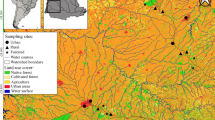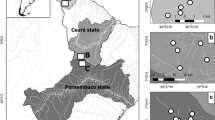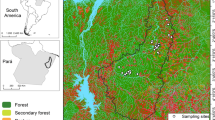Abstract
Changes in landscape composition caused by conversion of natural habitats into human-altered ecosystems can directly influence the physical characteristics of stream networks. Such impacts can modify the functional structure of fish communities, although the exact consequences of anthropic land-use changes can be context-dependent. This study investigated the influence of different land-use classes on the functional structure of fish communities in 32 headwater streams from southern Brazil. Trait composition and indices of functional diversity of the fish community were related to four land-use classes: native forest vegetation, silviculture, agriculture, and urban areas. Streams surrounded by larger areas of native forest were characterized by the predominance of foraging specialist species like grazers. However, as native vegetation is replaced by agriculture and urban areas, specialist species are replaced by species with generalist diet like detritivores. In streams surrounded by larger areas of agriculture, functional richness and divergence increased, while functional evenness decreased. Most likely, these changes were induced by alterations in the water quality, indicated by increased electrical conductivity and water temperature in streams with more agriculture areas. In conclusion, the conservation of the native forest vegetation is essential to maintain habitat characteristics and ecological processes in streams and to avoid the loss of specialist species in fish communities.



Similar content being viewed by others
References
Abelha MCF, Agostinho AA, Goulart E (2001) Plasticidade trófica em peixes de água doce. Acta Sci Biol Sci 23:425–434
Alexandre CV, Esteves KE (2010) Analysis of fish communities along a rural–urban gradient in a neotropical stream (Piracicaba River Basin, São Paulo, Brazil). Hydrobiologia 641:97–114. https://doi.org/10.1007/s10750-009-0060-y
Alvarez-Vázquez LJ, Fernández FJ, Muñoz-Sola R (2009) Mathematical analysis of a three-dimensional eutrophication model. J Math Anal Appl 3491:135–155. https://doi.org/10.1016/j.jmaa.2008.08.031
Amâncio DV, Coelho G, Marques RFDPV, Viola MR, de Mello CR (2018) Qualidade da água nas sub-bacias hidrográficas dos Rios Capivari e Mortes, Minas Gerais. Sci Agrar 19:75–86
Anderson EP, Maldonado-Ocampo JA (2011) A regional perspective on the diversity and conservation of tropical Andean fishes. Conserv Biol 25:30–39. https://doi.org/10.1111/j.1523-1739.2010.01568.x
Angermeier PL (1995) Ecological attributes of extinction-prone species: loss of freshwater fishes of Virginia. Conserv Biol 9:143–158. https://doi.org/10.1046/j.1523-1739.1995.09010143.x
Barbet-Massin M, Jetz W (2015) The effect of range changes on the functional turnover, structure and diversity of bird assemblages under future climate scenarios. Glob Change Biol 21:2917–2928. https://doi.org/10.1111/gcb.12905
Bierschenk AM, Mueller M, Pander J, Geist J (2019) Impact of catchment land use on fish community composition in the headwater areas of Elbe, Danube and Main Sci Total Environ 652:66–74. https://doi.org/10.1016/j.scitotenv.2018.10.218
Blanck A, Lamouroux N (2007) Large-scale intraspecific variation in life-history traits of European freshwater fish. J Biogeogr 34:862–875
Blume KK, Macedo JC, Meneguzzi A, Silva LBD, Quevedo DMD, Rodrigues MAS (2010) Water quality assessment of the Sinos River, southern Brazil. Braz J Biol 70:1185–1193
Brucet S, Pédron S, Mehner T, Lauridsen TL, Argillier C, Winfield IJ, Volta P, Emmrich M, Trygve H, Holmgren K, Benejam L, Kelly F, Krause T, Palm A, Rask M, Jeppesen E (2013) Fish diversity in European lakes: geographical factors dominate over anthropogenic pressures. Freshw Biol 58:1779–1793. https://doi.org/10.1111/fwb.12167
Burrell TK, O’Brien JM, Graham SE, Simon KS, Harding JS, McIntosh AR (2014) Riparian shading mitigates stream eutrophication in agricultural catchments. Freshw Sci 33:73–84
Cadotte MW (2011) The new diversity: management gains through insights into the functional diversity of communities. J Appl Ecol 48:1067–1069. https://doi.org/10.1111/j.1365-2664.2011.02056.x
de Carvalho Leitão ML, Lima Í, Hiroki KAN, Pelli A, de Souza F (2018) Diferenças ecomorfológicas e funcional em populações de Phalloceros harpagos Lucinda, 2008, na Bacia do alto rio Paraná. Biota Amazônia (Biote Amazonie, Biota Amazon, Amazon Biota) 8:34–38
Casatti L, Langeani F, Ferreira CP (2006) Effects of physical habitat degradation on the stream fish assemblage structure in a pasture region. Environ Manag 38:974. https://doi.org/10.1007/s00267-005-0212-4
Casatti L, de Paula FC, Carvalho FR (2009) Grass-dominated stream sites exhibit low fish species diversity and dominance by guppies: an assessment of two tropical pasture river basins. Hydrobiologia 632:273–283. https://doi.org/10.1007/s10750-009-9849-y
Casatti L, Teresa FB, Gonçalves-Souza T, Bessa E, Manzotti AR, Gonçalves CDS, Zeni JDO (2012) From forests to cattail: how does the riparian zone influence stream fish? Neotrop Ichthyol 10:205–214. https://doi.org/10.1590/S1679-62252012000100020
Casatti L, Teresa FB, de Oliveira Zeni J, Ribeiro MD, Brejao GL, Ceneviva-Bastos M (2015) More of the same: high functional redundancy in stream fish assemblages from tropical agroecosystems. Environ Manag 55:1300–1314. https://doi.org/10.1007/s00267-015-0461-9
Cianciaruso MV, Silva IA, Batalha MA (2009) Diversidades filogenética e funcional: novas abordagens para a ecologia de comunidades. Biota Neotrop 9. https://doi.org/10.1590/S1676-06032009000300008
Coe MT, Latrubesse EM, Ferreira ME, Amsler ML (2011) The effects of deforestation and climate variability on the streamflow of the Araguaia River, Brazil. Biogeochemistry 105:119–131
Comitesinos (2018) Caracterização da Bacia Hidrográfica do Rio dos Sinos. http://www.comitesinos.com.br/bacia-hidrografica-do-rio-dos-sinos. Accessed 20 Jan 2018
Corbi JJ, Strixino ST, Santos AD, Del Grande M (2006) Diagnóstico ambiental de metais e organoclorados em córregos adjacentes a áreas de cultivo de cana-de-açúcar (Estado de São Paulo, Brasil). Quím Nova 61–65. https://doi.org/10.1590/S0100-40422006000100013
Cornwell WK, Schwilk DW, Ackerly DD (2006) A trait-based test for habitat filtering: convex hull volume. Ecology 87:1465–1471
Cunico AM, Allan JD, Agostinho AA (2011) Functional convergence of fish assemblages in urban streams of Brazil and the United States. Ecol Ind 11:1354–1359. https://doi.org/10.1016/j.ecolind.2011.02.009
Dala-Corte RB, Giam X, Olden JD, Becker FG, Guimarães TDF, Melo AS (2016) Revealing the pathways by which agricultural land-use affects stream fish communities in South Brazilian grasslands. Freshw Biol 61:1921–1934
Devictor V, Julliard R, Clavel J, Jiguet F, Lee A, Couvet D (2008) Functional biotic homogenization of bird communities in disturbed landscapes. Glob Ecol Biogeogr 17:252–261
Dolédec S, Phillips N, Scarsbrook M, Riley RH, Townsend CR (2006) Comparison of structural and functional approaches to determining landuse effects on grassland stream invertebrate communities. J N Am Benthol Soc 25:44–60
Dosskey MG, Vidon P, Gurwick NP, Allan CJ, Duval TP, Lowrance R (2010) The role of riparian vegetation in protecting and improving chemical water quality in streams. JAWRA J Am Water Resour Assoc 46:261–277
Erős T, Heino J, Schmera D, Rask M (2009) Characterising functional trait diversity and trait–environment relationships in fish assemblages of boreal lakes. Freshw Biol 54:1788–1803. https://doi.org/10.1111/j.1365-2427.2009.02220.x
Fagan WF, Unmack PJ, Burgess C, Minckley WL (2002) Rarity, fragmentation, and extinction risk in desert fishes. Ecology 83:3250–3256. https://doi.org/10.1890/0012-9658(2002)083[3250:RFAERI]2.0.CO;2
Fauset S, Baker TR, Lewis SL, Feldpausch TR, Affum-Baffoe K, Foli EG, Hamer KC, Swaine MD (2012) Drought-induced shifts in the floristic and functional composition of tropical forests in Ghana. Ecolo Lett 15:1120–1129. https://doi.org/10.1111/j.1461-0248.2012.01834.x
Fernandes P, Antunes C, Pinho P, Máguas C, Correia O (2016) Natural regeneration of Pinus pinaster and Eucalyptus globulus from plantation into adjacent natural habitats. For Ecol Manag 378:91–102. https://doi.org/10.1016/j.foreco.2016.07.027
Fierro P, Bertrán C, Tapia J, Hauenstein E, Peña-Cortés F, Vergara C, Cerna C, Vargas-Chacoff L (2017) Effects of local land-use on riparian vegetation, water quality, and the functional organization of macroinvertebrate assemblages. Sci Total Environ 609:724–734. https://doi.org/10.1016/j.scitotenv.2017.07.197
Flynn DF, Gogol-Prokurat M, Nogeire T, Molinari N, Richers BT, Lin BB, DeClerck F (2009) Loss of functional diversity under land use intensification across multiple taxa. Ecol Lett 12:22–33
Freitas CEC, Siqueira-Souza FK (2009) O uso de peixes como bioindicador ambiental em áreas de várzea da bacia Amazônica. Rev Agrogeoambiental, 1. https://doi.org/10.18406/2316-1817v1n2200975
Garrick RC, Reppel DK, Morgan JT, Burgess S, Hyseni C, Worthington RJ, Ulyshen MD (2019) Trophic interactions among dead-wood-dependent forest arthropods in the southern Appalachian Mountains, USA. Food Webs 18:e00112. https://doi.org/10.1016/j.fooweb.2018.e00112
Giam X, Ng TH, Lok AF, Ng HH (2011) Local geographic range predicts freshwater fish extinctions in Singapore. J Appl Ecol 48:356–363. https://doi.org/10.1111/j.1365-2664.2010.01953.x
Guimarães RZ, de Oliveira FA, Gonçalves ML (2010) Avaliação dos impactos da atividade de silvicultura sobre a qualidade dos recursos hídricos superficiais. Sci 38:377–390
Hellawell JM, Abel R (1971) A rapid volumetric method for the analysis of the food of fishes. J Fish Biol 3:29–37
Hepp LU, Melo AS (2013) Dissimilarity of stream insect assemblages: effects of multiple scales and spatial distances. Hydrobiologia 703:239–246. https://doi.org/10.1007/s10750-012-1367-7
Hoeinghaus DJ, Winemiller KO, Birnbaum JS (2007) Local and regional determinants of stream fish assemblage structure: inferences based on taxonomic vs. functional groups. J Biogeogr 34:324–338. https://doi.org/10.1111/j.1365-2699.2006.01587.x
Honnen W, Rath K, Schlegel T, Schwinger A, Frahne D (2001) Chemical analyses of water, sediment and biota in two small streams in southwest Germany. J Aquat Ecosyst Stress Recov 8:195–213. https://doi.org/10.1023/A:1012945427446
Hood JM, Vanni MJ, Flecker AS (2005) Nutrient recycling by two phosphorus-rich grazing catfish: the potential for phosphorus-limitation of fish growth. Oecologia 146:247–257. https://doi.org/10.1007/s00442-005-0202-5
Iñiguez–Armijos C, Leiva A, Frede HG, Hampel H, Breuer L (2014) Deforestation and benthic indicators: how much vegetation cover is needed to sustain healthy Andean streams? PLoS ONE 9:e105869. https://doi.org/10.1371/journal.pone.0105869
Jeffries M (2008) The spatial and temporal heterogeneity of macrophyte communities in thirty small, temporary ponds over a period of ten years. Ecography 31:765–775. https://doi.org/10.1111/j.0906-7590.2008.05487.x
Keck BP, Marion ZH, Martin DJ, Kaufman JC, Harden CP, Schwartz JS, Strange RJ (2014) Fish functional traits correlated with environmental variables in a temperate biodiversity hotspot. PLoS ONE 9:e93237. https://doi.org/10.1371/journal.pone.0093237
Kelly DJ, Bothwell ML, Schindler DW (2003) Effects of solar ultraviolet radiation on stream benthic communities: an intersite comparison. Ecology 84:2724–2740. https://doi.org/10.1890/02-0658
Knoll LB, McIntyre PB, Vanni MJ, Flecker AS (2009) Feedbacks of consumer nutrient recycling on producer biomass and stoichiometry: separating direct and indirect effects. Oikos 118:1732–1742. https://doi.org/10.1111/j.1600-0706.2009.17367.x
Laliberté E, Legendre P, Shipley B, Laliberté ME (2014) FD: Measuring Functional Diversity from Multiple Traits, and Other Tools for Functional Ecology. R Package Version 1.0-12
Lavorel S, Grigulis K, McIntyre S, Williams NS, Garden D, Dorrough J, Bonis A (2008) Assessing functional diversity in the field–methodology matters! Funct Ecol 22:134–147. https://doi.org/10.1111/j.1365-2435.2007.01339.x
van der Lee AS, Koops MA (2015) Are small fishes more sensitive to habitat loss? A generic size-based model. Can J Fish Aquat Sci 73:716–726. https://doi.org/10.1139/cjfas-2015-0026
Legendre P, Legendre LF (2012) Numerical ecology, 24. Elsevier, Amsterdam
Longman EK, Rosenblad K, Sax DF (2018) Extreme homogenization: the past, present and future of mammal assemblages on islands. Glob Ecol Biogeogr 27:77–95. https://doi.org/10.1111/geb.12677
Lorion CM, Kennedy BP (2009) Riparian forest buffers mitigate the effects of deforestation on fish assemblages in tropical headwater streams. Ecol Appl 19:468–479
Lucena CAS, Calegari BB, Pereira EHL, Dallegrave E (2013) O uso de óleo de cravo na eutanásia de peixes. Bol Soc Bras Ictiol 105:20–24
Lujan NK, German DP, Winemiller KO (2011) Do wood-grazing fishes partition their niche?: morphological and isotopic evidence for trophic segregation in Neotropical Loricariidae. Funct Ecol 25:1327–1338. https://doi.org/10.1111/j.1365-2435.2011.01883.x
Maidment DR (2002) Arc Hydro: GIS for water resources. ESRI, Inc., New York
Maluf JRT (2000) Nova classificação climática do Estado do Rio Grande do Sul. Rev Bra Agr 8:141–150
Marsh-Matthews E, Matthews WJ (2000) Geographic, terrestrial and aquatic factors: which most influence the structure of stream fish assemblages in the midwestern United States? Ecol Freshw Fish 9:9–21. https://doi.org/10.1034/j.1600-0633.2000.90103.x
Mason NW, Mouillot D, Lee WG, Wilson JB (2005) Functional richness, functional evenness and functional divergence: the primary components of functional diversity. Oikos 111:112–118. https://doi.org/10.1111/j.0030-1299.2005.13886.x
Mayfield MM, Bonser SP, Morgan JW, Aubin I, McNamara S, Vesk PA (2010) What does species richness tell us about functional trait diversity? Predictions and evidence for responses of species and functional trait diversity to land-use change. Glob Ecol Biogeogr 19:423–431. https://doi.org/10.1111/j.1466-8238.2010.00532.x
Oksanen J, Blanchet FG, Kindt R, Legendre P, Minchin PR, O’hara RB, Simpson GL, Peter M, Stevens HH, Szoecs E, Wagner H (2018) Vegan: community ecology package. R package version. 117–118. https://github.com/vegandevs/vegan
Olden JD, Kennard MJ, Lawler JJ, Poff NL (2011) Challenges and opportunities in implementing managed relocation for conservation of freshwater species. Conserv Biol 25:40–47. https://doi.org/10.1111/j.1523-1739.2010.01557.x
Oliveira DCD, Bennemann ST (2005) Ictiofauna, recursos alimentares e relações com as interferências antrópicas em um riacho urbano no sul do Brasil. Biota Neotrop 5:95–107. https://doi.org/10.1590/S1676-06032005000100011
Oliveira PTS, Leite MB, Mattos T, Nearing MA, Scott RL, de Oliveira Xavier R, Wendland E (2017) Groundwater recharge decrease with increased vegetation density in the Brazilian cerrado. Ecohydrology 10:e1759. https://doi.org/10.1002/eco.1759
Pease AA, González-Díaz AA, Rodiles-Hernández ROCÍO, Winemiller KO (2012) Functional diversity and trait–environment relationships of stream fish assemblages in a large tropical catchment. Freshw Biol 57:1060–1075. https://doi.org/10.1111/j.1365-2427.2012.02768.x
Peres-Neto PR, Legendre P, Dray S, Borcard D (2006) Variation partitioning of species data matrices: estimation and comparison of fractions. Ecology 87:261–42625. https://doi.org/10.1890/00129658(2006)87[2614:VPOSDM]2.0.CO;2
Poff NL, Allan JD (1995) Functional organization of stream fish assemblages in relation to hydrological variability. Ecology 76:606–627. https://doi.org/10.2307/1941217
Poff NL, Olden JD, Vieira NK, Finn DS, Simmons MP, Kondratieff BC (2006) Functional trait niches of North American lotic insects: traits-based ecological applications in light of phylogenetic relationships. J North Am Benthol Soc 25:730–755. https://doi.org/10.1899/0887-3593(2006)025[0730:FTNONA]2.0.CO;2
Pote DH, Reed BA, Daniel TC, Nichols DJ, Moore PA, Edwards DR, Formica S (2001) Water-quality effects of infiltration rate and manure application rate for soils receiving swine manure. J Soil Water Conserv 56:32–37
Presidência da República (2012) Lei 12.651. http://www.planalto.gov.br/ccivil_03/_ato2011-2014/2012/lei/l12651.htm. Accessed 15 Jan 2020
R Core Team (2018) R: a language and environment for statistical computing, reference index version 3.5.1. R Foundation for Statistical Computing, Vienna, Austria. https://www.R-project.org/
Rabeni CF, Jacobson RB (1993) The importance of fluvial hydraulics to fish-habitat restoration in low-gradient alluvial streams. Freshw Biol 29:211–220. https://doi.org/10.1111/j.1365-2427.1993.tb00758.x
Reynolds JD, Webb TJ, Hawkins LA (2005) Life history and ecological correlates of extinction risk in European freshwater fishes. Can J Fish Aquat Sci 62:854–862. https://doi.org/10.1139/f05-066
Rocha FCD, Casatti L, Carvalho FR, Silva AMD (2009) Fish assemblages in stream stretches occupied by cattail (Typhaceae, Angiospermae) stands in Southeast Brazil. Neotrop Ichthyol 7:241–250
Schindler DE, Eby LA (1997) Stoichiometry of fishes and their prey: implications for nutrient recycling. Ecology 78:1816–1831. https://doi.org/10.1890/0012-9658(1997)078[1816:SOFATP]2.0.CO;2
Smucker NJ, Kuhn A, Cruz-Quinones CJ, Serbst JR, Lake JL (2018) Stable isotopes of algae and macroinvertebrates in streams respond to watershed urbanization, inform management goals, and indicate food web relationships. Ecol Indic 90:295–304
Stauffer JC, Goldstein RM, Newman RM (2000) Relationship of wooded riparian zones and runoff potential to fish community composition in agricultural streams. Can J Fish Aquat Sci 57:307–316. https://doi.org/10.1139/f07-183
Strahler AN (1957) Quantitative analysis of watershed geomorphology. Civ Eng 101:1258–1262
Tales E, Keith P, Oberdorff T (2004) Density-range size relationships in French riverine fishes. Oecologia 138:360–370. https://doi.org/10.1007/s00442-003-1430-1
Tanentzap AJ, Szkokan-Emilson EJ, Kielstra BW, Arts MT, Yan ND, Gunn JM (2014) Forests fuel fish growth in freshwater deltas. Nat Commun 5:4077. https://doi.org/10.1038/ncomms5077
Teresa FB, Casatti L (2010) Importância da vegetação ripária em região intensamente desmatada no sudeste do Brasil: um estudo com peixes de riacho. Pan-Am J Aquat Sci 5:444–453
Teresa FB, Casatti L (2012) Influence of forest cover and mesohabitat types on functional and taxonomic diversity of fish communities in Neotropical lowland streams. Ecol Freshw Fish 21:433–442. https://doi.org/10.1111/j.1600-0633.2012.00562.x
Teresa FB, Casatti L (2017) Trait-based metrics as bioindicators: responses of stream fish assemblages to a gradient of environmental degradation. Ecol Ind 75:249–258. https://doi.org/10.1016/j.ecolind.2016.12.041
Teresa FB, Casatti L, Cianciaruso MV (2015) Functional differentiation between fish assemblages from forested and deforested streams. Neotrop Ichthyol https://doi.org/10.1590/1982-0224-20130229
Tilman D (2001) Functional diversity. Encycl Biodivers 3:109–120
Tundisi JG (2008) Recursos hídricos no futuro: problemas e soluções. Estudos avançados 22:7–16
Urrea-Clos G, García-Berthou E, Sabater S (2014) Factors explaining the patterns of benthic chlorophyll-a distribution in a large agricultural Iberian watershed (Guadiana river). Ecol Ind 36:463–469. https://doi.org/10.1016/j.ecolind.2013.09.007
Vannote RL, Minshall GW, Cummins KW, Sedell JR, Cushing CE (1980) The river continuum concept. Can J Fish Aquat Sci 37:130–137. https://doi.org/10.1139/f80-017
Verberk WC, Van Noordwijk CGE, Hildrew AG (2013) Delivering on a promise: integrating species traits to transform descriptive community ecology into a predictive science. Freshw Sci 32:531–547. https://doi.org/10.1899/12-092.1
Villéger S, Brosse S, Mouchet M, Mouillot D, Vanni MJ (2017) Functional ecology of fish: current approaches and future challenges. Aquat Sci 79:783–801. https://doi.org/10.1007/s00027-017-0546-z
Villéger S, Grenouillet G, Brosse S (2014) Functional homogenization exceeds taxonomic homogenization among E uropean fish assemblages. Glob Ecol Biogeogr 23:1450–1460. https://doi.org/10.1111/geb.12226
Villéger S, Mason NW, Mouillot D (2008) New multidimensional functional diversity indices for a multifaceted framework in functional ecology. Ecology 89:2290–2301
Villéger S, Miranda JR, Hernández DF, Mouillot D (2010) Contrasting changes in taxonomic vs. functional diversity of tropical fish communities after habitat degradation. Ecol Appl 20:1512–1522. https://doi.org/10.1890/09-1310.1
Violle C, Navas ML, Vile D, Kazakou E, Fortunel C, Hummel I, Garnier E (2007) Let the concept of trait be functional!. Oikos 116:882–892. https://doi.org/10.1111/j.2007.0030-1299.15559.x
Wallace JB, Eggert SL, Meyer JL, Webster JR (1997) Multiple trophic levels of a forest stream linked to terrestrial litter inputs. Science 277:102–104. https://doi.org/10.1126/science.277.5322.102
Walsh CJ, Roy AH, Feminella JW, Cottingham PD, Groffman PM, Morgan RP (2005) The urban stream syndrome: current knowledge and the search for a cure. J North Am Benthol Soc 24:706–723. https://doi.org/10.1899/04-028.1
Wang B, Liu D, Liu S, Zhang Y, Lu D, Wang L (2012) Impacts of urbanization on stream habitats and macroinvertebrate communities in the tributaries of Qiangtang River, China. Hydrobiologia 680:39–51. https://doi.org/10.1007/s10750-011-0899-6
Zippin C (1958) The removal method of population estimation. J Wildl Manag 22:82–90
Acknowledgements
We are grateful to Marlon Ferraz da Rosa for the development of the map and help with fieldwork. We thank Rafael Gomes de Moura for helping in the analysis of land use. This research was funded by grants from the Coordination for the Improvement of Higher Education Personnel (CAPES) and the Brazilian National Council for Scientific and Technological Development (CNPq, grant numbers: 151152/2018-7 and 307455/2016-5).
Author Contributions
ASB participated in data acquisition, data analysis, and drafting of the manuscript. MMP participated in data analysis and drafting of the manuscript. UHS was the supervisor of the doctoral thesis of ASB. He contributed to the ecological framework of the thesis and provided the infrastructure for the study.
Author information
Authors and Affiliations
Corresponding author
Ethics declarations
Conflict of Interest
The authors declare that they have no conflict of interest.
Additional information
Publisher’s note Springer Nature remains neutral with regard to jurisdictional claims in published maps and institutional affiliations.
Supplementary information
Rights and permissions
About this article
Cite this article
Barbosa, A.S., Pires, M.M. & Schulz, U.H. Influence of Land-Use Classes on the Functional Structure of Fish Communities in Southern Brazilian Headwater Streams. Environmental Management 65, 618–629 (2020). https://doi.org/10.1007/s00267-020-01274-9
Received:
Accepted:
Published:
Issue Date:
DOI: https://doi.org/10.1007/s00267-020-01274-9




